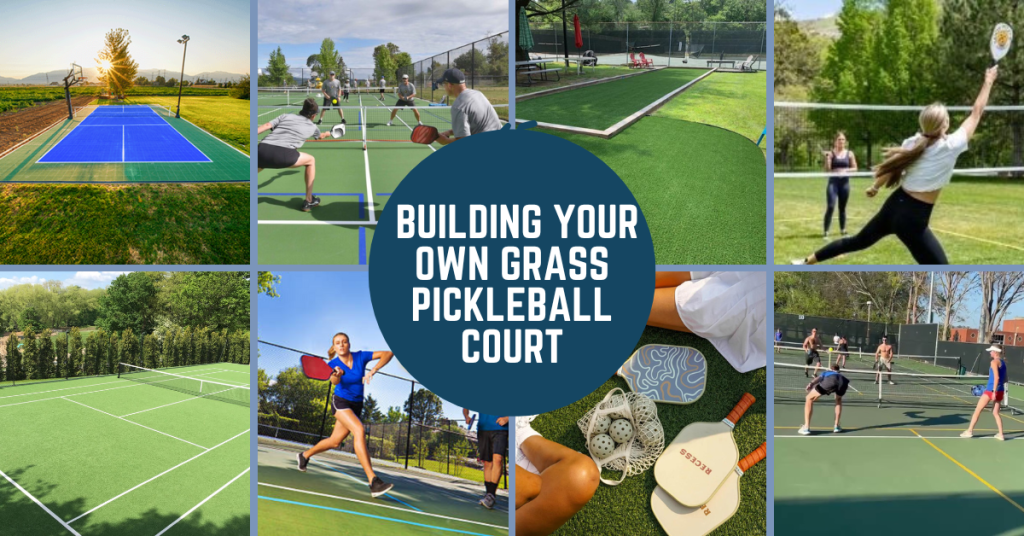
Pickleball is one of the fastest-growing sports in the United States. Originally invented in 1965, pickleball combines elements of tennis, badminton, and ping pong. It is played on a badminton-sized court with a slightly modified tennis net, using paddles and a plastic ball with holes. Pickleball can be played indoors or outdoors on a variety of surfaces. One of the most popular outdoor surfaces for pickleball is grass. Let’s take a look at everything you need to know about building your own grass pickleball court in your own backyard.
Grass pickleball court dimensions
Chapters
ToggleThe dimensions and layout of a pickleball court are regulated by the USA Pickleball Association (USAPA). For a regulation-sized outdoor pickleball court on grass, the court dimensions are:
- Length – 44 feet
- Width – 20 feet
- Total area – 880 square feet
The court is striped similar to a tennis court, with a net in the middle that hangs at 36 inches at the sidelines and 34 inches in the center.
Unlike hard surfaces like asphalt or concrete, grass courts do not require precise lines and markings. However, it is still recommended to measure out and mark the basic boundaries and service lines with white paint or chalk. This will help you set up a portable net properly and allow for accurate scoring.
Gear Needed for a Lawn Pickleball Set
To set up pickleball on your grass lawn, you will need some basic gear:
- Portable pickleball net – Many different portable nets are available, with center heights adjustable from 34-36 inches. They usually come with ground stakes or weighted bases for setup on grass.
- Paddles – You will need a paddle for each player. Pickleball paddles have a large surface and lightweight, comfortable grip.
- Pickleballs – The perforated plastic balls used for pickleball are much lighter than tennis balls. Lawn pickleball balls are made to be more durable on grass surfaces.
- Court boundary markers – Use chalk, tape, cones, or painted lines to mark boundaries.
- Net posts – For a permanent court, install net posts in the ground approximately 22 feet apart.
Preparing and Maintaining a Grass Pickleball Court
When building a pickleball court in your own yard, you’ll need to take some important steps to prepare the grass surface.
- Remove any weeds, rocks, or sticks from the court area. Debris can create safety hazards and uneven ball bounces.
- Level the surface as much as possible. Significant dips or bumps will affect play.
- Mow the grass very short – ideally around 1/2 inch high. Longer grass will slow down the ball and affect shots.
- After heavy use, grass courts may develop bare or thin patches. Overseed with turfgrass seed to maintain thick, durable grass coverage.
- Water and fertilize the court area regularly to encourage healthy, lush grass growth.
- In very hot weather, syringe or lightly mist the court with water to prevent the grass from drying out.
Proper lawn care and maintenance will maximize playability and prevent your grass court from turning into a dirt patch.
Ideal Grass Types for Pickleball Court Dimensions
When choosing a type of grass for your pickleball court, look for a hardy, fine-bladed turfgrass that can withstand frequent foot traffic and play. Some top grass options include:
- Bermudagrass – Warm season grass with good wear tolerance. Requires frequent mowing.
- Perennial ryegrass – Fast-growing cool season grass. Maintains color in winter.
- Fine fescue – Shade-tolerant cool season grass. Slow growth habit.
- Kentucky bluegrass – Popular cool season grass for lawns. Forms a lush, dense turf.
Your local climate will determine what grass varieties perform best in your area. A turfgrass expert can recommend the ideal grass seed mix for establishing a durable pickleball court.
Can You Play Pickleball on Artificial Turf?
For players who want maximum playability with minimum maintenance, artificial turf is an excellent surface choice for pickleball courts. The key advantages of artificial turf include:
- Consistent ball bounce and ball speed
- Limited maintenance required – no mowing or watering
- Cushioned to reduce injury risk
- Playable in all weather conditions
- No bare or thin spots develop
- Cooler surface temperature than natural grass
- Typically lasts 10+ years outdoors
Artificial turf designed for sports use provides great traction and mimics the playing characteristics of a real grass court. Just be sure to select a high-quality turf and have it professionally installed for optimal performance.
Consider a Pickleball Glass Court for Year-Round Play
Avid pickleball players can enjoy the game all year by having a glass pickleball court built. These climate-controlled courts feature:
- Glass panels or walls surrounding the court
- Cushioned sports flooring
- Heating and air conditioning systems
- Lighting for indoor/outdoor play
Glass court walls typically have a high netting above them to allow balls to stay in play. The glass helps block wind and provides a consistent indoor playing environment protected from the elements.
Backyard pickleball courts with retractable glass panels are also available. The glass can slide open to transform the space into an open-air court during nice weather.
Though more expensive to construct, an enclosed or retractable glass pickleball court enables comfortable play regardless of the season or weather conditions.
Conclusion
A DIY grass pickleball court is a great way to enjoy this fun, active game right in your own backyard. With the right turfgrass, gear, and regular lawn maintenance, you can create a smooth, lush playing surface tailored for pickleball. Whether you prefer real grass or artificial turf, building your own permanent or portable court is an excellent investment for hours of pickleball enjoyment with family and friends.
FAQs
The standard size for a backyard grass Pickleball court is 20 feet by 44 feet, adhering to official court dimensions.
While various grass types can be considered, it’s advisable to choose grass varieties with good durability and recovery, such as Bermuda or Zoysia.
Ground preparation involves clearing the area, leveling the ground, adding a base layer of gravel, and ensuring proper drainage to prevent waterlogging.
Fencing is recommended to contain the ball during play and enhance the overall court experience. It adds to safety and ensures the game remains within the designated area.
Regular mowing is crucial to maintaining court aesthetics. Mow the grass to a height of around 3/4 to 1 inch, depending on the specific grass type.
Temporary paint or chalk can be used for court lines. Alternatively, consider using removable tape for a non-permanent solution.
Regular maintenance involves mowing, edging, and addressing any bare spots. Additionally, consider aerating the grass to enhance its health.
Sharing is caring!
